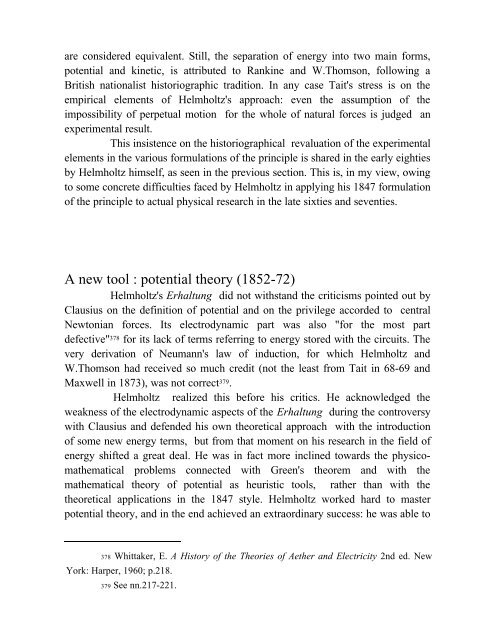Conservation and Innovation : Helmholtz's Struggle with Energy ...
Conservation and Innovation : Helmholtz's Struggle with Energy ...
Conservation and Innovation : Helmholtz's Struggle with Energy ...
You also want an ePaper? Increase the reach of your titles
YUMPU automatically turns print PDFs into web optimized ePapers that Google loves.
are considered equivalent. Still, the separation of energy into two main forms,<br />
potential <strong>and</strong> kinetic, is attributed to Rankine <strong>and</strong> W.Thomson, following a<br />
British nationalist historiographic tradition. In any case Tait's stress is on the<br />
empirical elements of <strong>Helmholtz's</strong> approach: even the assumption of the<br />
impossibility of perpetual motion for the whole of natural forces is judged an<br />
experimental result.<br />
This insistence on the historiographical revaluation of the experimental<br />
elements in the various formulations of the principle is shared in the early eighties<br />
by Helmholtz himself, as seen in the previous section. This is, in my view, owing<br />
to some concrete difficulties faced by Helmholtz in applying his 1847 formulation<br />
of the principle to actual physical research in the late sixties <strong>and</strong> seventies.<br />
A new tool : potential theory (1852-72)<br />
<strong>Helmholtz's</strong> Erhaltung did not <strong>with</strong>st<strong>and</strong> the criticisms pointed out by<br />
Clausius on the definition of potential <strong>and</strong> on the privilege accorded to central<br />
Newtonian forces. Its electrodynamic part was also "for the most part<br />
defective" 378 for its lack of terms referring to energy stored <strong>with</strong> the circuits. The<br />
very derivation of Neumann's law of induction, for which Helmholtz <strong>and</strong><br />
W.Thomson had received so much credit (not the least from Tait in 68-69 <strong>and</strong><br />
Maxwell in 1873), was not correct 379.<br />
Helmholtz realized this before his critics. He acknowledged the<br />
weakness of the electrodynamic aspects of the Erhaltung during the controversy<br />
<strong>with</strong> Clausius <strong>and</strong> defended his own theoretical approach <strong>with</strong> the introduction<br />
of some new energy terms, but from that moment on his research in the field of<br />
energy shifted a great deal. He was in fact more inclined towards the physicomathematical<br />
problems connected <strong>with</strong> Green's theorem <strong>and</strong> <strong>with</strong> the<br />
mathematical theory of potential as heuristic tools, rather than <strong>with</strong> the<br />
theoretical applications in the 1847 style. Helmholtz worked hard to master<br />
potential theory, <strong>and</strong> in the end achieved an extraordinary success: he was able to<br />
378 Whittaker, E. A History of the Theories of Aether <strong>and</strong> Electricity 2nd ed. New<br />
York: Harper, 1960; p.218.<br />
379 See nn.217-221.
















